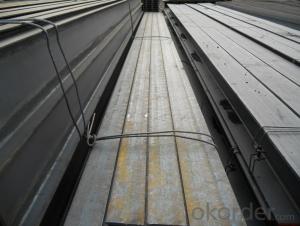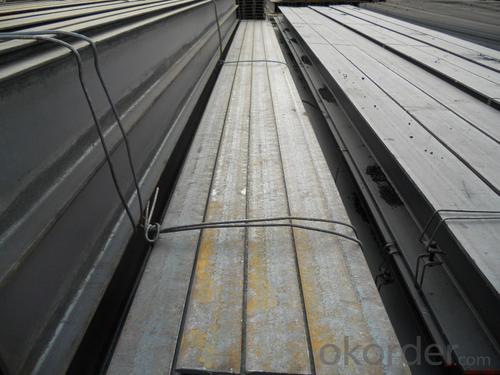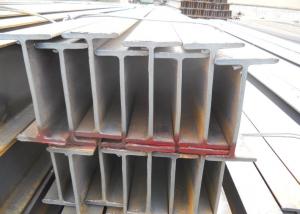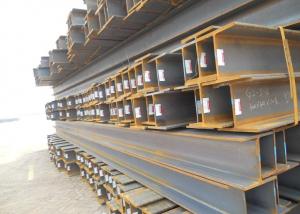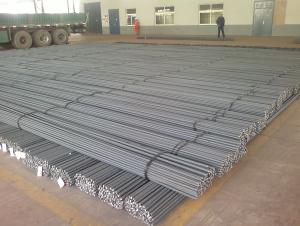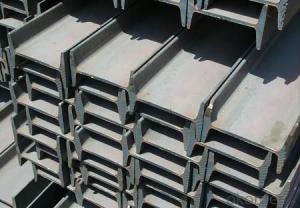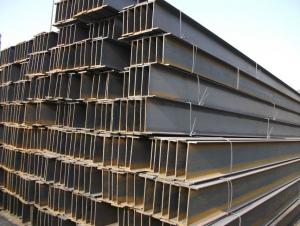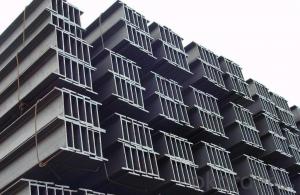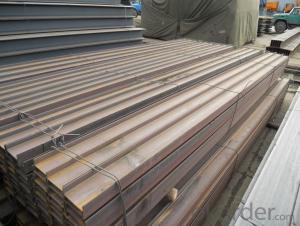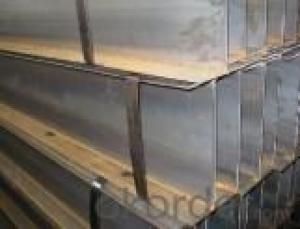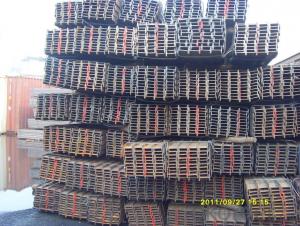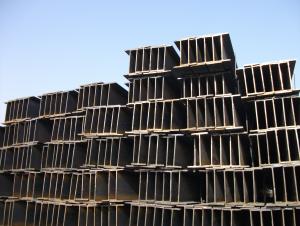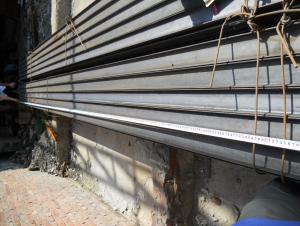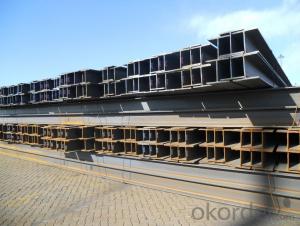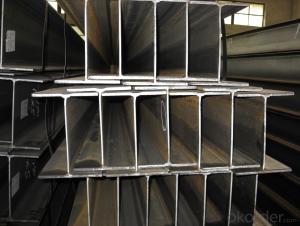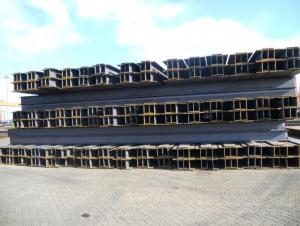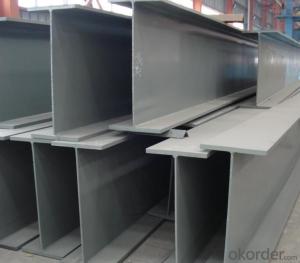Hot Rolled Steel JIS H Beam Small Size
- Loading Port:
- China Main Port
- Payment Terms:
- TT or LC
- Min Order Qty:
- -
- Supply Capability:
- -
OKorder Service Pledge
OKorder Financial Service
You Might Also Like
Product Description:
OKorder is offering high quality Hot Rolled Steel I-Beams at great prices with worldwide shipping. Our supplier is a world-class manufacturer of steel, with our products utilized the world over. OKorder annually supplies products to European, North American and Asian markets. We provide quotations within 24 hours of receiving an inquiry and guarantee competitive prices.
Product Applications:
Hot Rolled Steel I-Beams are ideal for structural applications and are widely used in the construction of buildings and bridges, and the manufacturing, petrochemical, and transportation industries.
Product Advantages:
OKorder's Steel I-Beams are durable, strong, and resist corrosion.
Main Product Features:
· Premium quality
· Prompt delivery & seaworthy packing (30 days after receiving deposit)
· Corrosion resistance
· Can be recycled and reused
· Mill test certification
· Professional Service
· Competitive pricing
Product Specifications:
Manufacture: Hot rolled
Grade: Q195 – 235
Certificates: ISO, SGS, BV, CIQ
Length: 6m – 12m, as per customer request
Packaging: Export packing, nude packing, bundled
SIZE(mm) | DIMENSION(kg/m) |
100*100 | 16.9 |
125*125 | 23.6 |
150*75 | 14 |
150*150 | 31.1 |
148*100 | 20.7 |
198*99 | 17.8 |
200*100 | 20.9 |
248*124 | 25.1 |
250*125 | 29 |
Packaging & Delivery of Hot Rolled Structural Steel H Beam
1. Packing: it is nude packed in bundles by steel wire rod
2. Bundle weight: not more than 3.5MT for bulk vessel; less than 3 MT for container load
3. Marks:
Color marking: There will be color marking on both end of the bundle for the cargo delivered by bulk vessel. That makes it easily to distinguish at the destination port.
Tag mark: there will be tag mark tied up on the bundles. The information usually including supplier logo and name, product name, made in China, shipping marks and other information request by the customer.
If loading by container the marking is not needed, but we will prepare it as customer request.
4. Transportation: the goods are delivered by truck from mill to loading port, the maximum quantity can be loaded is around 40MTs by each truck. If the order quantity cannot reach the full truck loaded, the transportation cost per ton will be little higher than full load.
5. Delivered by container or bulk vessel
FAQ:
Q1: How soon can we receive the product after purchase?
A1: Within three days of placing an order, we will begin production. The specific shipping date is dependent upon international and government factors, but is typically 7 to 10 workdays.
Q2: What makes stainless steel stainless?
A2: Stainless steel must contain at least 10.5 % chromium. It is this element that reacts with the oxygen in the air to form a complex chrome-oxide surface layer that is invisible but strong enough to prevent further oxygen from "staining" (rusting) the surface. Higher levels of chromium and the addition of other alloying elements such as nickel and molybdenum enhance this surface layer and improve the corrosion resistance of the stainless material.
Q3: Can stainless steel rust?
A3: Stainless does not "rust" as you think of regular steel rusting with a red oxide on the surface that flakes off. If you see red rust it is probably due to some iron particles that have contaminated the surface of the stainless steel and it is these iron particles that are rusting. Look at the source of the rusting and see if you can remove it from the surface.
Images:
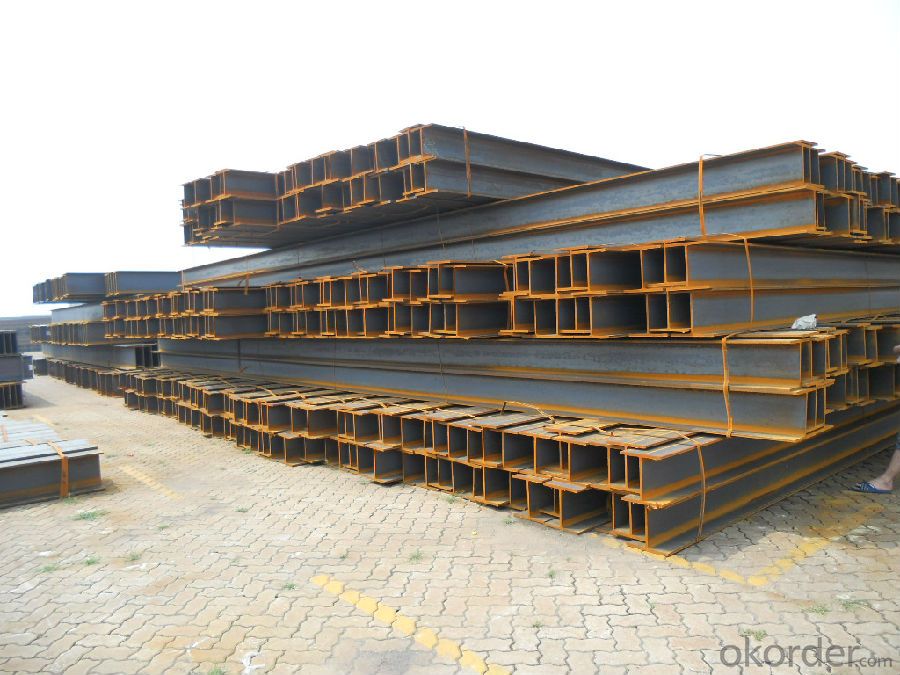
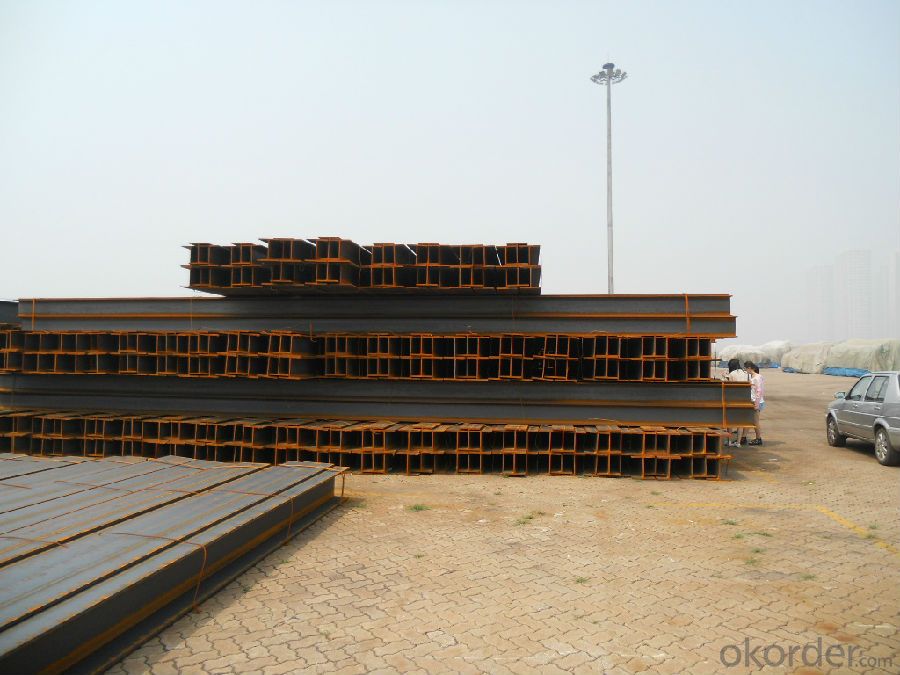
- Q: How do steel H-beams contribute to the overall sustainability of a transportation hub?
- Steel H-beams contribute to the overall sustainability of a transportation hub in several ways. Firstly, steel H-beams are known for their structural strength and durability, making them an ideal choice for constructing large-scale transportation hubs. Due to their high strength-to-weight ratio, H-beams require fewer materials to achieve the same level of structural support, resulting in reduced resource consumption. This not only helps to conserve natural resources but also minimizes the environmental impact associated with the extraction, manufacturing, and transportation of construction materials. Furthermore, steel H-beams are recyclable, meaning that they can be repurposed or reused at the end of their lifespan. This attribute aligns with the principles of a circular economy, which aims to minimize waste and maximize resource efficiency. By incorporating recyclable materials like steel H-beams into the construction of transportation hubs, we can reduce the amount of construction waste sent to landfills and promote a more sustainable approach to infrastructure development. In addition to their strength and recyclability, steel H-beams also contribute to the sustainability of transportation hubs through their ability to withstand extreme weather conditions. These beams offer excellent resistance to forces such as high winds, earthquakes, and heavy loads, thereby ensuring the long-term stability and safety of the transportation hub. This resilience reduces the need for frequent repairs or replacements, saving both time and resources in the long run. Lastly, steel H-beams can be prefabricated offsite, allowing for efficient construction processes and minimizing disruption to the surrounding environment. Prefabrication reduces construction time, energy consumption, and waste generation, all of which contribute to the overall sustainability of the transportation hub. In conclusion, steel H-beams play a vital role in enhancing the overall sustainability of a transportation hub. Their strength, durability, recyclability, resistance to extreme weather, and ability to be prefabricated contribute to reducing resource consumption, promoting a circular economy, minimizing waste, and ensuring long-term stability. By incorporating steel H-beams into the design and construction of transportation hubs, we can create more sustainable and resilient infrastructure for the future.
- Q: Can steel H-beams be used for manufacturing facilities?
- Yes, steel H-beams can be used for manufacturing facilities. Steel H-beams are commonly used in the construction industry for various applications, including manufacturing facilities. They offer high strength, durability, and load-bearing capabilities, making them suitable for supporting heavy machinery, equipment, and structures within manufacturing plants. H-beams provide a strong framework and can be easily fabricated and installed, making them an ideal choice for constructing manufacturing facilities that require large open spaces and wide spans. Additionally, steel H-beams can withstand high temperatures, making them suitable for industries that involve heat-intensive processes. Overall, steel H-beams are a versatile and reliable choice for constructing manufacturing facilities due to their structural integrity and ability to accommodate heavy loads.
- Q: Can steel H-beams be customized according to specific project requirements?
- Yes, steel H-beams can be customized according to specific project requirements. Steel H-beams are versatile structural elements that are commonly used in construction projects. They can be customized in terms of size, length, and thickness to meet the specific needs of a project. The customization process involves working closely with steel fabricators to determine the exact dimensions and specifications required for the project. This allows for the creation of H-beams that are tailor-made to fit the specific structural requirements, ensuring optimal performance and safety. Customization options also include surface treatments, such as galvanization or coatings, to enhance durability and corrosion resistance. Overall, steel H-beams offer a high degree of flexibility and can be customized to suit a wide range of project requirements.
- Q: What are the different types of steel H-beam connections used in residential buildings?
- Residential buildings commonly utilize various types of steel H-beam connections to ensure stability and strength for the overall structure. Here are some examples: 1. Welded Connection: The most frequently used connection method in residential buildings involves directly welding the H-beam to the supporting structure, such as columns or beams. This technique employs high-strength welding techniques to provide excellent strength and rigidity, making it suitable for applications with heavy loads or high lateral forces. 2. Bolted Connection: Another option is to use high-strength bolts to connect the H-beam to the supporting structure. This method offers easy installation and allows for convenient disassembly or modification when necessary. Bolted connections are commonly employed in situations that require adjustability or removability of the H-beam, such as mezzanine floors or temporary structures. 3. Shear Plate Connection: This type of connection involves placing steel plates on both sides of the H-beam, which are then bolted together. By distributing the load from the beam to the supporting structure, shear plate connections provide excellent strength and stability. They are commonly utilized when the H-beam needs to withstand heavy loads or moments. 4. Clip Angle Connection: Clip angle connections utilize steel angles that are welded to both the H-beam and the supporting structure. These angles provide additional support and rigidity to the connection. Clip angle connections are often employed in situations where the H-beam needs to resist lateral loads or uplift forces. 5. Moment Connection: Moment connections are specifically designed to resist rotational forces or moments. These connections combine welding and bolting techniques to ensure a rigid and strong connection between the H-beam and the supporting structure. Moment connections are frequently used to support large cantilevered structures or heavy loads. It is worth noting that the selection of a specific type of steel H-beam connection for a residential building depends on various factors, including load requirements, architectural design, and recommendations from structural engineers.
- Q: Are steel H-beams compatible with other construction materials?
- Yes, steel H-beams are compatible with other construction materials. Steel H-beams are commonly used in construction due to their high strength-to-weight ratio, durability, and versatility. They can be easily integrated with various materials such as concrete, wood, and other metals. For instance, steel H-beams can be used as structural support in combination with concrete slabs or wooden beams to create a strong and stable framework for buildings or bridges. Additionally, they can be welded or bolted together with other steel components to form complex structures. Overall, steel H-beams are highly compatible with other construction materials and can be effectively utilized in a wide range of construction projects.
- Q: Can Steel H-Beams be recycled or reused?
- Yes, Steel H-Beams can be recycled and reused. Steel is one of the most recycled materials in the world, and H-Beams are no exception. When H-Beams are no longer needed, they can be collected and taken to recycling centers or scrap yards. The beams are then melted down and transformed into new steel products. Recycling H-Beams reduces the demand for raw materials and helps to conserve energy and resources. Additionally, if the H-Beams are still in good condition, they can be reused in construction projects, providing cost-effective and sustainable solutions. Overall, the ability to recycle and reuse Steel H-Beams contributes to a more environmentally friendly and sustainable construction industry.
- Q: What is the maximum length of a steel H-beam that can be manufactured?
- The maximum length of a steel H-beam that can be made depends on various factors, including the manufacturing process, transportation limitations, and practical constraints. Concerning the manufacturing process, steel H-beams are typically produced in set lengths, which can vary depending on the specific steel mill or manufacturer. These standard lengths typically range from 20 to 60 feet (6 to 18 meters). However, it is worth noting that longer lengths can often be requested or fabricated based on specific project requirements. Transportation restrictions also play a significant role in determining the maximum length of a steel H-beam. The beam's length must be able to fit within the constraints of transportation methods such as trucks, trains, or ships. Each of these transportation methods has its own size limitations, and going beyond these limits may necessitate special arrangements, permits, or even partial disassembly of the beam. Lastly, practical limitations must be considered when determining the maximum length of a steel H-beam. Lengthier beams can pose challenges in terms of handling, maneuvering, and installation at construction sites. The weight and size of the beam can make transportation and lifting more difficult, potentially requiring specialized equipment or additional manpower. In conclusion, while there are standard lengths for steel H-beams, the maximum length that can be manufactured is influenced by the manufacturing process, transportation restrictions, and practical considerations. Custom orders, transportation logistics, and practical limitations all contribute to determining the maximum length of a steel H-beam.
- Q: Are there any standards or codes that govern the use of steel H-beams?
- Steel H-beams are governed by a variety of standards and codes. One well-known standard is the AISC specification, which provides guidelines for designing, fabricating, and erecting structural steel. This specification outlines requirements for H-beams, including dimensions, strength, and connection details. In the United States, the IBC is a widely accepted set of regulations that establishes minimum requirements for building design and construction. It references industry standards, including the AISC specification, to ensure the safe and efficient use of structural steel, including H-beams. Different countries have their own specific standards and codes for steel H-beams. For example, Europe commonly uses the Eurocode system, which offers a unified set of design codes for various construction materials, including steel. The Eurocodes address specific provisions for H-beams, such as material properties, design principles, and construction details. Engineers, architects, and construction professionals must be familiar with these standards and codes when using steel H-beams to ensure compliance with safety, performance, and quality requirements. Following these standards helps maintain the integrity and stability of structures, enhancing safety and longevity in the built environment.
- Q: Can steel H-beams be used in gymnasium structures?
- Certainly, gymnasium structures can incorporate steel H-beams. Thanks to their robustness and durability, steel H-beams are frequently employed in construction projects. They offer remarkable stability and support, rendering them ideal for expansive areas such as gymnasiums. Furthermore, steel H-beams can be readily tailored and fabricated to meet the precise design prerequisites of a gymnasium. They possess the ability to endure substantial loads and guarantee the essential structural integrity requisite for gymnasium structures.
- Q: How do steel H-beams perform in areas with high humidity and moisture?
- Steel H-beams are well-suited for areas with high humidity and moisture due to their durability and resistance to corrosion. However, it is important to properly maintain and protect these beams in order to ensure their longevity. In environments with elevated levels of moisture, it is crucial to protect steel H-beams from corrosion. Moisture, especially when combined with oxygen and contaminants, can cause rust to form on the surface of the beams. This rust can compromise the structural integrity of the steel, potentially reducing its ability to bear loads. To prevent corrosion and maintain the performance of steel H-beams in these conditions, several measures can be taken. One common approach is to apply protective coatings, such as galvanization or painting. Galvanization involves coating the steel with a layer of zinc, which acts as a sacrificial barrier, protecting the underlying steel from corrosion. Painting with corrosion-resistant coatings can also provide a similar protective effect. In addition to protective coatings, it is important to install proper drainage and ventilation systems to minimize moisture accumulation around the H-beams. Regular inspections and maintenance are also crucial to promptly identify and address any signs of corrosion or damage. In conclusion, steel H-beams can be used in areas with high humidity and moisture, but it is necessary to take preventive measures to ensure their long-term performance and structural integrity. By implementing protective coatings, drainage systems, and regular maintenance, the risk of corrosion can be significantly reduced, allowing steel H-beams to effectively function in such environments.
Send your message to us
Hot Rolled Steel JIS H Beam Small Size
- Loading Port:
- China Main Port
- Payment Terms:
- TT or LC
- Min Order Qty:
- -
- Supply Capability:
- -
OKorder Service Pledge
OKorder Financial Service
Similar products
Hot products
Hot Searches
Related keywords
